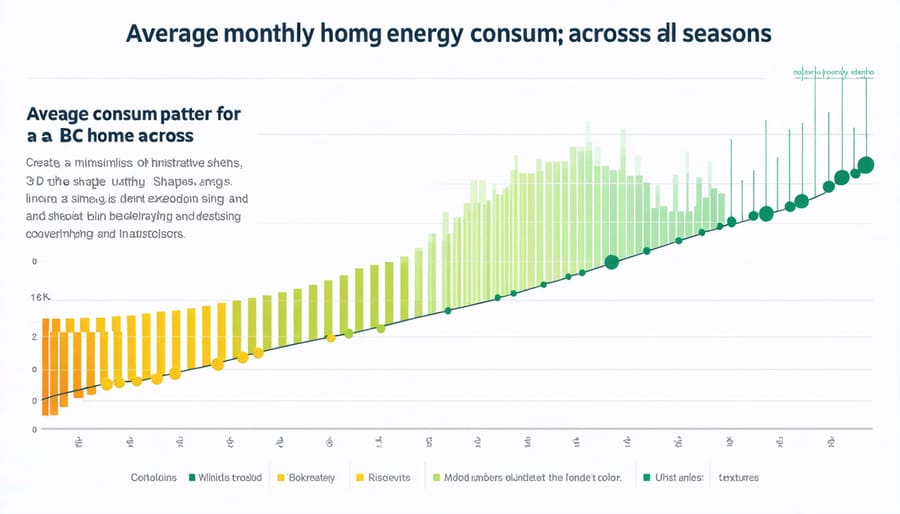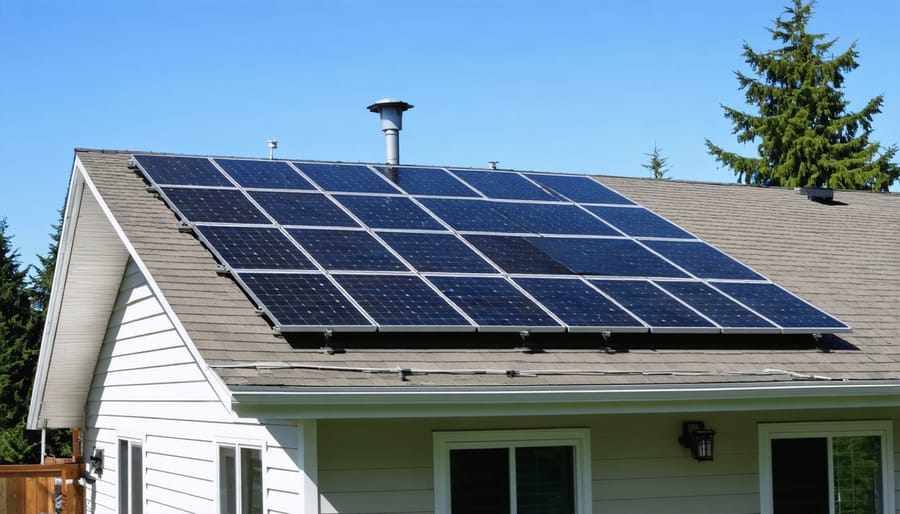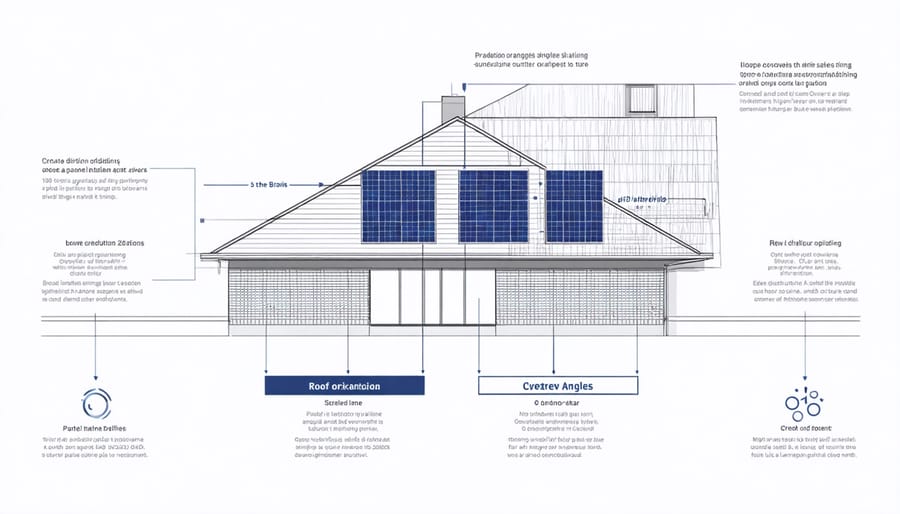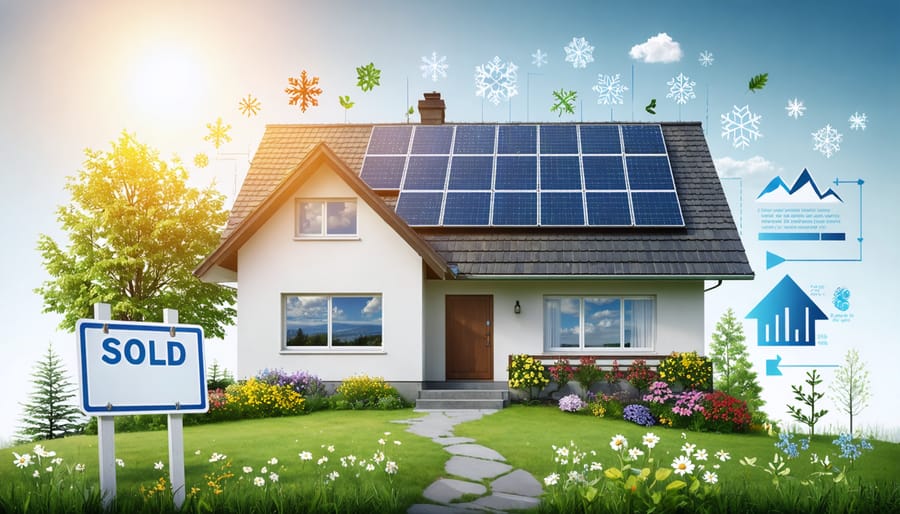The average residential solar system in British Columbia ranges from 6 to 10 kilowatts (kW), powering typical homes that consume 11,000 kilowatt-hours (kWh) annually. Size your system precisely by calculating your household’s actual energy usage from the past 12 months of BC Hydro bills, factoring in local sunshine hours and roof orientation. A well-designed 8kW system generally requires 24-28 solar panels and produces enough electricity to offset 80-90% of a family home’s power needs, while staying within the BC Hydro net metering program limits. Climate-conscious homeowners across Greater Vancouver are discovering that right-sized solar installations not only slash electricity bills but also increase property values by an average of 4.1% while reducing carbon footprints by up to 5 tonnes annually.
Understanding BC Home Energy Needs
Average BC Home Power Usage
In British Columbia, average household energy consumption typically ranges between 10,000 and 12,000 kWh per year. This consumption pattern varies significantly with seasonal changes, with higher usage during the darker, colder winter months when both lighting and heating demands increase. Space heating accounts for approximately 50% of total energy use in BC homes, while water heating represents about 20%. The remaining 30% is distributed among appliances, lighting, and electronics.
A typical BC household uses more electricity in the evening hours, creating a distinctive peak between 4 PM and 9 PM when families return home from work and school. During summer months, consumption patterns shift earlier in the day, particularly in homes with air conditioning. Understanding these usage patterns is crucial for properly sizing your solar system to meet your household’s specific energy needs throughout the year.

Seasonal Energy Variations
British Columbia’s distinct seasonal patterns significantly impact solar system performance and sizing requirements. During summer months, particularly June and July, homeowners can expect peak solar production with up to 16 hours of daylight. However, winter months see considerably reduced production, with December averaging only 8 hours of daylight and frequent cloud cover.
To account for these variations, BC homeowners typically need larger solar arrays than similar homes in sunnier regions. A system that produces excess energy during summer can help offset the reduced winter production through BC Hydro’s net metering program. Most BC homeowners find that sizing their system about 20-25% larger than their current annual energy needs provides optimal year-round coverage.
The coastal regions experience milder but cloudier conditions, while interior regions like the Okanagan Valley benefit from more sunny days, allowing for slightly smaller system sizes to achieve the same annual output. Regular snow clearing during winter months helps maintain optimal production throughout the year.
Common Solar System Sizes for BC Homes
Small Systems (3-6 kW)
Small residential solar systems ranging from 3 to 6 kW are ideal for compact homes, townhouses, and energy-efficient households in British Columbia. These systems typically consist of 8-16 solar panels and can generate between 3,000 to 6,000 kWh annually, depending on your location and roof orientation.
A 3-6 kW system works well for households with modest energy consumption, typically using 8,000 kWh or less per year. In Vancouver and Victoria, where many heritage homes have been upgraded with energy-efficient appliances and LED lighting, these smaller systems often provide 40-60% of annual electricity needs.
These configurations are particularly suitable for:
– Single-story homes with limited roof space
– Townhouses and semi-detached homes
– Households with 1-3 occupants
– Homes with energy-efficient upgrades
– Properties with partial sun exposure
Many BC homeowners find that small systems offer an excellent balance between initial investment and energy production, with installation costs typically ranging from $9,000 to $18,000 before incentives.
Medium Systems (6-9 kW)
Medium-sized solar systems, ranging from 6 to 9 kW, are increasingly popular among BC families living in average-sized homes with moderate energy needs. These systems typically consist of 20-30 solar panels and can generate between 6,000 to 9,000 kWh annually in British Columbia’s climate.
A 7.5 kW system, for example, can effectively power a three-bedroom home with standard appliances, including an electric water heater and a heat pump. This size is particularly well-suited for households with annual electricity consumption between $1,800 and $2,700.
Many Vancouver Island homeowners have found success with medium systems, especially those who’ve switched to electric vehicles. The Fraser Valley Family Center, for instance, installed a 7.2 kW system in 2022 and now generates enough power to offset 80% of their annual energy consumption while charging their family EV.
Medium systems typically require 400-600 square feet of roof space and can be installed in various configurations to maximize sun exposure. The installation cost generally ranges from $18,000 to $27,000 before rebates and incentives.

Large Systems (9+ kW)
Large residential solar systems exceeding 9 kW are becoming increasingly common in British Columbia, particularly for homes with substantial energy needs or specific sustainability goals. These installations are ideal for larger properties, multi-generational households, or homes with high electricity consumption due to features like electric vehicle charging, heat pumps, or heated pools.
In Metro Vancouver, we’ve seen several successful installations of 12-15 kW systems that completely offset annual electricity usage while providing surplus power during summer months. These larger systems typically require 30-40 solar panels and considerable roof space, but they offer maximum energy independence and the highest potential for BC Hydro net metering benefits.
While the initial investment is higher, many homeowners find that larger systems make financial sense when planning for future needs, such as adding electric vehicles or home additions. Some BC communities, like Salt Spring Island and Kelowna, have embraced these bigger installations to achieve complete energy self-sufficiency, especially in areas where power outages are more frequent.
Consider a larger system if you’re planning significant home improvements, expect increased energy needs, or want to maximize your contribution to BC’s clean energy future.
Determining Your Ideal System Size
Energy Bill Analysis
To accurately determine your ideal solar system size, start by analyzing your past 12 months of electricity bills. Look for your monthly kilowatt-hour (kWh) consumption, which is clearly displayed on each BC Hydro bill. Add these numbers together to get your annual energy usage.
For example, if your household uses 1,000 kWh per month on average, your yearly consumption would be 12,000 kWh. Keep in mind that usage often varies seasonally, with higher consumption during darker winter months in BC.
Pay special attention to your Step 1 and Step 2 rates on your BC Hydro bill, as this two-tier system affects your potential savings. Many BC homeowners aim to offset their Step 2 consumption first, as it’s charged at a higher rate.
Consider your future energy needs too. If you’re planning to add an electric vehicle or heat pump, factor in this additional consumption. For most accurate sizing, share your electricity bills with local solar installers who can analyze your consumption patterns and recommend an appropriately sized system for your home.
Roof Space and Orientation
Your available roof space and its orientation play crucial roles in determining your solar system’s size and efficiency. In British Columbia, an optimal solar panel orientation typically faces south with a tilt angle between 30-45 degrees, though east and west-facing installations can still be effective.
A typical residential solar panel requires about 17-20 square feet of roof space, and most BC homes need between 12-16 panels for an average system. This means you’ll need approximately 200-320 square feet of unshaded roof area for a standard installation.
Consider physical obstacles like chimneys, vents, and dormers when calculating available space. While creative mounting solutions exist, working around these features may limit your system’s size. Additionally, local building codes and setback requirements might restrict installation areas near roof edges.
For homes with limited roof space, high-efficiency panels can help maximize power generation in smaller areas. Some homeowners also explore ground-mounted systems as an alternative when roof constraints are too restrictive.

Future Energy Needs
When planning your solar system size, it’s crucial to consider future energy needs. Many BC homeowners are transitioning to electric vehicles, with the province seeing a significant increase in EV adoption each year. An average EV can add 2,500-4,000 kWh to your annual electricity consumption, potentially requiring an additional 4-6 solar panels to offset this usage.
Home additions or renovations, such as adding a heat pump, expanding living space, or installing a hot tub, can also significantly impact your energy requirements. A heat pump typically adds 3,000-5,000 kWh annually to your consumption, while a hot tub might add 2,400-3,000 kWh.
To future-proof your solar installation, consider installing a slightly larger system than currently needed or ensuring your roof has space for additional panels. Some homeowners opt for a modular approach, starting with a base system that can be expanded later. This strategy allows for gradual investment while maintaining the flexibility to meet growing energy demands.
Remember that BC’s net metering program allows you to bank excess energy credits, making it beneficial to plan ahead for increased consumption.
Cost vs. Size Considerations
The relationship between system size and cost follows a relatively straightforward pattern in BC’s residential solar market. Typically, homeowners can expect to invest between $2.50 and $3.50 per watt of installed capacity, with larger systems often offering better economies of scale. For example, a 6kW system might cost around $18,000 to $21,000, while a 10kW system could range from $25,000 to $35,000 before incentives and rebates.
While larger systems require a bigger upfront investment, they often provide better long-term value. The solar panel payback period tends to be shorter for appropriately sized systems that match your household consumption patterns. Many BC homeowners find that systems between 6kW and 10kW offer the sweet spot between initial cost and long-term savings.
Consider that undersizing your system to save money initially might lead to higher electricity bills and missed opportunities for BC’s net metering benefits. Conversely, oversizing without proper planning could result in unnecessary expenses. Working with local installers to analyze your energy needs can help strike the right balance between system size and cost-effectiveness.
Choosing the right solar system size for your BC home doesn’t have to be complicated. The typical 6-8kW system works well for many households, but your specific needs may vary based on your energy consumption, roof space, and budget. Remember to start by reviewing your BC Hydro bills and consulting with local solar professionals who understand our unique climate and regulations. Take advantage of available rebates and incentives, and consider future energy needs when making your decision. By carefully evaluating these factors and working with experienced installers, you can confidently move forward with a solar system that meets your household’s needs while contributing to BC’s sustainable energy future. Ready to take the next step? Schedule a professional assessment to get a customized recommendation for your home.

